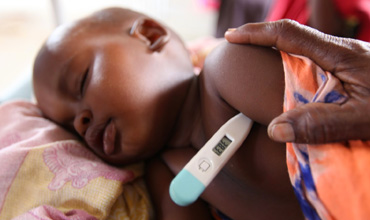Mothers Management of Malaria Fever among Under-Five Nomadic Fulani Children of Northeastern Nigeria: Role of Nursing

Abstract:
Malaria is a deadly disease which is spread widely in the tropical regions of the world with holoendemicity in Sub-Saharan Africa. An investigation of fever management among mothers of under-five children was carried out in nomadic Fulani settlements of Adamawa State Nigeria. Management of fever was assessed through interviews and questionnaires. Nearly half of the nomadic Fulani mothers (49.47%) did not take any action within 24 hours when their children had fever. This was not significantly different (p < 0.05) with regard to age, clan and parity of the mothers. The duration between mother’s recognition and management of fever showed that almost half (49.6%) of the mothers did not take time into consideration during intervention of fever. Mothers of under-five who acted within 24 hours of noticing of fever in their children were 30.6%, while those who acted after 24 hours were 12.0%. There was no significant difference (p < 0.05) between mothers’ recognition of fever and management based on age, clan and parity. Home management of fever by most nomadic Fulani mothers was not satisfactory. Similarly, timely intervention of fever was not considered by most nomadic Fulani mothers. There is the need for appropriate education and adoption of new strategies for timely intervention of disease causing fever among the nomadic Fulani population.References:
[1]. Adams, I., omer, E. S.
M., Saleh., Khamis, A. H. and Malik, E. M. Perceptions of the causes of malaria
and of its complications, treatment and prevention among midwives and pregnant women
of Eastern Sudan. J Pub Hlth, 16(2):129-132, 2009.
[2]. Akogun, O. B. and John, K. K. Illness
related practices for the management of childhood malaria among the Bwatiye people
of north-eastern Nigeria. Mal J, 4: 13, 2005.
[3]. Abdikarim, Sheik-Mohammed and Jolian,
P. V. Where health care has no access; the nomadic population of Sub-sahara Africa.
Trop MedintlHlth, 4 (10): 677-770, 1999.
[4]. Akogun O.B, Gundiri M.A, Badaki, J.A.,
Njobdi S.Y, Adesina A.A, Ogundahunsi, O.T. Febrile illness experience among Nigerian
nomads. International Journal for Equity in Health, 11:5, 2012.
[5]. Agyepong, L. A. Malaria ethno-medical
perceptions and practice in an Adangbefarming community and implication for control.
SocSciMed, 35: 131-137, 1992.
[6]. Arnaud Dzeing-Ella, Pascal, C. N. O.,
Rose, T., Timothy, T., Beatrice, M., Monique, M., Ulrich Muller-Roeme, Joseph, J.
and Eric, K. Severe falciparum malaria in Gabonese children: Clinical and Laboratory
features. Mal J, 4:1-11, 2005.
[7]. Bonilla, E. and Rodriguez, P. Tropical
disease and socio-economic development: the case of malaria in Nebe, O. J., Adeoye, G. O., Agomo, P. U. and
Mosanyan, M. E. Malaria in a coastal area of Lagos state Nigeria: A survey of perceptions
and practices Amongst mothers/caregivers of children under five years old. Nig JParasitol,
23:69-80, 2002.
[8]. Cox, S. E., Staalsoe, T. and Arthur, P.
Maternal vitamin A Supplementation and immunity to malaria in pregnancy in Ghanianprimigravids.
Trop MedIntlHlth, 10:1286-1297, 2005.
[9]. Chabasse, D., Roure, C., Rhadby, agRanqueph
and Ouilici, M. The health of nomads and semi-nomads of the Malian Gourma; An epidemiology
approach in: Population Health and Nutrition in the Sahel 2ndedn. Aghlu. Routledge
and Kegan Paul, London; 319-339, 1985.
[10]. Colombia. Presented at the WHO/PAHO interregional
conference on malaria. Brasilia. Brazil; 1992.
[11]. D’allessandro, U., Olaleye, B., Meghuire,
W., et al., Reduction in mortality
and morbidity from malaria in Gambian children following the introduction of a national
insecticide impregnated bed net program. Lancet, 345 (8948): 479-483, 1995.
[12]. Daniel, M. and Okenu, N. An Integrated
Approach for malaria control in Africa. Mal and infect dis in Afr, 3:104-113, 1999.
[13]. Hughes, S. and Kelly, P. Interactions
of malnutrition and immune impairment with specific reference to immunity against
parasite. Immunol, 28(11):577-588, 2006.
[14]. Hill, Z., kendali, C., Arthur, P., Kirwood,
B. and Adjei, E. Recognizing childhood illness and their traditional explanations:
exploring options for care-seeking interventions in the context of the IMCI strategy
in rural Ghana. Acta Trop, 8:668-676, 2003.
[15]. Lamprey, H. F. Pastoralism yesterday
and today: the overgrazing problem in tropical savannah (ed. F. Bouliere), Elseveir,
Armsterdam. 643-666, 1983.
[16]. Lepers, J. P., Deloron, P., Andriamagatan-Rason,
M. D. Ramaramiraja, J. A. and Coulange, P. Newly transmitted Plasmodium falciparum
malaria in the central high Plateaux of madagascar: assessment of clinical impact
in a rural community. Bul. WrldHlth Org, 682: 139-280, 1990.
[17]. Miller, L. H., Baruch, D. J., Marsh,
K. and Doumbo, O. K. The pathogenic basis of malaria. Ntr, 415: 673-679, 2002.
[18]. Moluneaix, L. and Cramicara, S. Research
on epidemiology and control of malaria in the Sudan Savannah of West Africa. The
Garth Project, World Health Organization, Geneva; 1980, 125-131.
[19]. Molta, N. B. Burden of malaria in Africa,.
A paper presented at the African Summit on Roll Back Malaria. Abuja Technical Session,
2000. (Unpublished).
[20]. Njuguna, P. W. and Newton, C. R. Management
of severe falciparum malaria. J Pg Med, 50:45-50, 2004.
[21]. Nuwaha, F. People’s perceptions of malaria
in Mbarara, Uganda. Trop Med IntlHlth, 7: 462-470, 2002.
[22]. Omar, M. A. Health care for the no mads.
WrldHlth Forum, 13: 307-310, 1992.
[23]. Oshikoya, K. A. and Senbanjo, I. O. Fever
in children: mothers perceptions and their home management. Iran JPaed, 18(3): 229-236,
2008.
[24]. Salako, L. A. Malaria the unending Saga.
Proceedings of the Update symposium on rational use of antimalarial drugs, May and
BakerPLC, Ikeja, Nigeria, 1997.
[25]. Taylor, D. W., Zhou, A., Marsillio, L.
E., et al., Antibodies that inhibit
binding of Plasmodium falciparum-infected erythrocytes to chondroitin sulfate A
and to the C terminus of merozoite surface protein 1 correlate with reduced placental
malaria in Cameroonian women. Infect Immunol, 72:1603-1607, 2004.
[26]. World Health Organization. Tropical disease
Research; Progress 1997-1998 14thProgramme Report of the UNDP/WORLD BANK/WHO
special programme for research and training in Tropical disease. WrldHlth Org Bull,
1-10, 1999.
[27]. Uko, E. K., Emeribe, A. O. and Ejezie,
G. C. Pattern of malaria parasitaemia in pregnancy in Calabar. J Med Lab Sc, 7:
18-20, 1998.
[28]. Uko, E. K., Emeribe, A. O. and Ejezie,
G. C. Pattern of malaria parasitaemia in pregnancy in Calabar. J Med Lab Sc, 7:
18-20, 1998.
[29]. World Health Organization. A strategic
frame work for malaria prevention and control during pregnancy in the African region.
Brazzaville: WrldHlth Org, 16-21, 2004.
[30]. World Health Organization. Malaria diagnosis. New perspective. Report of a joint W.H.O./USAID informal consultation. 25-27 October, 1999. Geneva; 2000.
[31]. White, N. J. The management of severe falciparum malaria. AmerJ Resp Critical Care Med, 167: 673-674, 2003.

